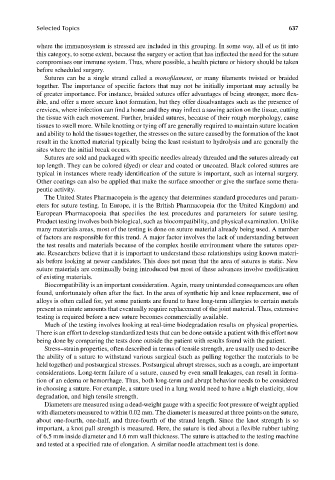Page 674 - Carrahers_Polymer_Chemistry,_Eighth_Edition
P. 674
Selected Topics 637
where the immunosystem is stressed are included in this grouping. In some way, all of us fi t into
this category, to some extent, because the surgery or action that has inflected the need for the suture
compromises our immune system. Thus, where possible, a health picture or history should be taken
before scheduled surgery.
Sutures can be a single strand called a monofi lament, or many filaments twisted or braided
together. The importance of specific factors that may not be initially important may actually be
of greater importance. For instance, braided sutures offer advantages of being stronger, more fl ex-
ible, and offer a more secure knot formation, but they offer disadvantages such as the presence of
crevices, where infection can find a home and they may inflect a sawing action on the tissue, cutting
the tissue with each movement. Further, braided sutures, because of their rough morphology, cause
tissues to swell more. While knotting or tying off are generally required to maintain suture location
and ability to hold the tissues together, the stresses on the suture caused by the formation of the knot
result in the knotted material typically being the least resistant to hydrolysis and are generally the
sites where the initial break occurs.
Sutures are sold and packaged with specific needles already threaded and the sutures already cut
top length. They can be colored (dyed) or clear and coated or uncoated. Black colored sutures are
typical in instances where ready identification of the suture is important, such as internal surgery.
Other coatings can also be applied that make the surface smoother or give the surface some thera-
peutic activity.
The United States Pharmacopeia is the agency that determines standard procedures and param-
eters for suture testing. In Europe, it is the British Pharmacopeia (for the United Kingdom) and
European Pharmacopoeia that specifies the test procedures and parameters for suture testing.
Product testing involves both biological, such as biocompatibility, and physical examination. Unlike
many materials areas, most of the testing is done on suture material already being used. A number
of factors are responsible for this trend. A major factor involves the lack of understanding between
the test results and materials because of the complex hostile environment where the sutures oper-
ate. Researchers believe that it is important to understand these relationships using known materi-
als before looking at newer candidates. This does not mean that the area of sutures is static. New
suture materials are continually being introduced but most of these advances involve modifi cation
of existing materials.
Biocompatibility is an important consideration. Again, many unintended consequences are often
found, unfortunately often after the fact. In the area of synthetic hip and knee replacement, use of
alloys is often called for, yet some patients are found to have long-term allergies to certain metals
present as minute amounts that eventually require replacement of the joint material. Thus, extensive
testing is required before a new suture becomes commercially available.
Much of the testing involves looking at real-time biodegradation results on physical properties.
There is an effort to develop standardized tests that can be done outside a patient with this effort now
being done by comparing the tests done outside the patient with results found with the patient.
Stress–strain properties, often described in terms of tensile strength, are usually used to describe
the ability of a suture to withstand various surgical (such as pulling together the materials to be
held together) and postsurgical stresses. Postsurgical abrupt stresses, such as a cough, are important
considerations. Long-term failure of a suture, caused by even small leakages, can result in forma-
tion of an edema or hemorrhage. Thus, both long-term and abrupt behavior needs to be considered
in choosing a suture. For example, a suture used in a lung would need to have a high elasticity, slow
degradation, and high tensile strength.
Diameters are measured using a dead-weight gauge with a specific foot pressure of weight applied
with diameters measured to within 0.02 mm. The diameter is measured at three points on the suture,
about one-fourth, one-half, and three-fourth of the strand length. Since the knot strength is so
important, a knot pull strength is measured. Here, the suture is tied about a flexible rubber tubing
of 6.5 mm inside diameter and 1.6 mm wall thickness. The suture is attached to the testing machine
and tested at a specified rate of elongation. A similar needle attachment test is done.
9/14/2010 3:44:03 PM
K10478.indb 637
K10478.indb 637 9/14/2010 3:44:03 PM

